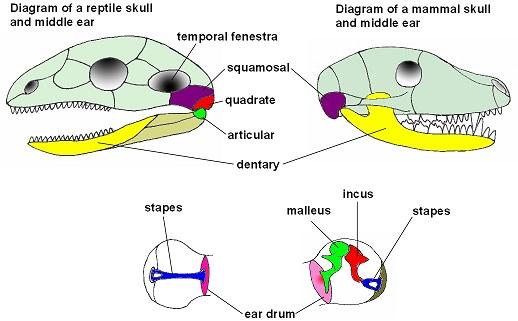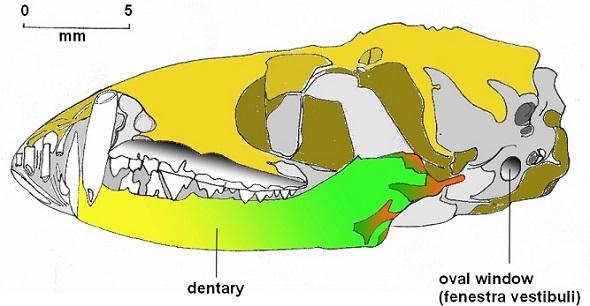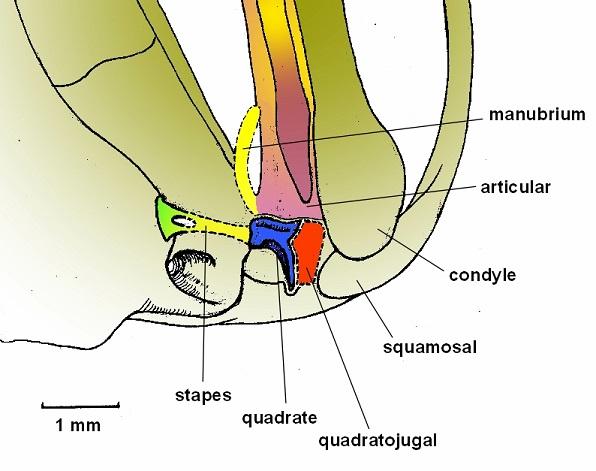
Changing the way we look at the world
This blog post is about the theory that mammals evolved from creatures called therapsids (which were a subgroup of non-mammalian synapsids) which according to evolutionists lived about 200 million years ago.
This includes the supposed evolutionary transition from creatures with one ear ossicle and a quadrate-articular (reptilian) jaw joint to mammals with three ear ossicles and a dentary-squamosal (mammalian) jaw joint.
The diagram below shows the names and relative positions of different bones in the jaw and the middle ear bones (ossicles) of reptiles and mammals.

According to this Wikipedia article,
“The evolution of mammalian auditory ossicles was an evolutionary event that resulted in the formation of the bones of the mammalian middle ear. These bones, or ossicles, are a defining characteristic of all mammals. The event is well-documented and important as a demonstration of transitional forms and exaptation, the re-purposing of existing structures during evolution” (downloaded 8th May 2020).
However, according to the abstract of a paper, published in 2016 in the Journal of Anatomy, on the subject of the evolution of the mammalian middle ear, there are some major problems with the evolutionary account. The authors Maier and Ruf wrote:
“(…) a number of morphological details remained to be solved, such as the origin of the tympanic membrane. (…). The present review emphasizes the problem of how the mammalian middle ear structures that developed at the angle of the lower jaw were transferred to the basicranium (…)”
To find out more go here.
Creation biologists have shown that actually there is no gradual evolutionary progression. Rather there are major discontinuities and reversals which seriously undermine the theory that mammals evolved from non-mammals. See here to read about it.
Evolutionists get around these problems by invoking homoplasy (parallel evolution),
One fossil which is supposed to show a key stage of the evolutionary transition is Morganucodon.
I have been looking into various aspects of this story and decided to get hold of a copy of one of key papers on Morganucodon (the abstract can be found here) which claimed to show that it had a double jaw joint, which was a key step in the evolution of the jaw and middle ear bones. I wanted to read this paper because it is often cited and Morganucodon is a very important part of the evolutionary story. When I started reading the paper, I could not believe how poor the evidence was and the amount of guess work which was involved. Nevertheless, the paper is cited and modified diagrams of Morganucodon are presented to support the case for evolution. Most people just assume that the evidence is good, without checking the source data, which shows that the modifications are based on very flimsy evidence and a lot of guess-work guided by evolutionary assumptions.
The current evolutionary theory is that animals with a reptilian jaw joint gradually evolved a mammalian jaw joint. The dentary bone increased in size and formed a secondary jaw joint with the squamosal bone of the skull side by side with the articular-quadrate reptilian jaw joint. According to this theory the articular and quadrate were also part of the system for hearing (the so-called mandibular ear). The theory is that the new jaw joint took over and the articular and quadrate were separated from the jaw and became the malleus and the incus, respectively. At the same time an eardrum evolved as a new sound receiver. At the end of the process the dentary bone became the only bone of the lower jaw and mammals had a more efficient ear.
Which brings us to the publication I mentioned above, on the skull of Morganucodon which Kermack and colleagues published in 1981 with a detailed description of the fossil skull of Morganucodon.
Here is my drawing of the skull which is based on figure 2 from that paper.

Notice that rear part of the dentary was broken off. The skull was damaged and none of the jaw joint and ear bones were attached.
Nevertheless, Morganucodon is claimed to have had a double jaw joint, that is, both a dentary-squamosal (mammalian) joint and a quadrate-articular (reptilian) joint which were side by side. As shown in the diagram below (which I drew, based on Figure 91 of the paper by Kermack et al).

This reconstruction was made even though key parts were missing or found separately. Only a partial dentary bones was found. Furthermore, the squamosal, quadrate and articular were not attached. A complete squamosal bone has never been found and all were damaged. It is no surprise to read that, “the correct orientation of the squamosal was difficult”. Lastly, only the foot-plate of the stapes bone was found.
Therefore, key parts of the double jaw joint were inferred, as shown by dashed lines in the diagram above.
Another missing bone was the quadratojugal bone which has never been found. Yet the authors stated that “(…) its existence is certain from the presence of the facets on the quadrate and the squamosal with which it articulated” (emphasis added). They go on to write that, “The quadratojugal formed the main articulation between the quadrate complex and the squamosal”. Furthermore, Kermack et al wrote that the articular had two facets, one for the quadrate and another for the quadratojugal.
The fact that the reconstruction was based on the belief in the existence of the missing quadratojugal and that it linked the quadrate and squamosal, and was an important part of the jaw joint, makes their interpretation of the double jaw joint rather doubtful.
Nevertheless, a modified version of this diagram is repeatedly re-drawn as evidence of a transitional stage in the evolution of the mammal jaw and ear bones. The modifications which are made are significant. They all leave out the quadratojugal and close up the gap, while at the same time maintaining that Morganucodon had a double jaw joint. In addition, no attempt is made to explain the role of the two facets on the articular bone.
Another problem with the revised reconstruction is that if only the quadrate is involved in the reptilian joint, this requires a more robust articulation between the quadrate and the articular which would have limited its movement and consequently reduced its effectiveness in sound transmission as part of the so-called mandibular middle ear.
All of these problems with the joint between the quadrate, quadratojugal and articular are good reasons to conclude that Morganucodon only had a mammalian jaw joint between the dentary and squamosal. Both interpretations are equally valid unless and until more evidence is found.
Reading the original paper on Morganucodon has shown that there are many uncertainties and a lack of clear evidence for the double jaw joint of Morganucodon.
The available evidence is consistent with suggestion that Morganucodon had only a dentary-squamosal jaw joint and that it was a mammal.
There is clear gap between Morganucodon and the proposed therapsid ancestors.
The argument for Morganucodon as a transitional fossil with a double jaw joint is clearly a matter of interpretation.
This includes the supposed evolutionary transition from creatures with one ear ossicle and a quadrate-articular (reptilian) jaw joint to mammals with three ear ossicles and a dentary-squamosal (mammalian) jaw joint.
The diagram below shows the names and relative positions of different bones in the jaw and the middle ear bones (ossicles) of reptiles and mammals.

According to this Wikipedia article,
“The evolution of mammalian auditory ossicles was an evolutionary event that resulted in the formation of the bones of the mammalian middle ear. These bones, or ossicles, are a defining characteristic of all mammals. The event is well-documented and important as a demonstration of transitional forms and exaptation, the re-purposing of existing structures during evolution” (downloaded 8th May 2020).
However, according to the abstract of a paper, published in 2016 in the Journal of Anatomy, on the subject of the evolution of the mammalian middle ear, there are some major problems with the evolutionary account. The authors Maier and Ruf wrote:
“(…) a number of morphological details remained to be solved, such as the origin of the tympanic membrane. (…). The present review emphasizes the problem of how the mammalian middle ear structures that developed at the angle of the lower jaw were transferred to the basicranium (…)”
To find out more go here.
Creation biologists have shown that actually there is no gradual evolutionary progression. Rather there are major discontinuities and reversals which seriously undermine the theory that mammals evolved from non-mammals. See here to read about it.
Evolutionists get around these problems by invoking homoplasy (parallel evolution),
One fossil which is supposed to show a key stage of the evolutionary transition is Morganucodon.
I have been looking into various aspects of this story and decided to get hold of a copy of one of key papers on Morganucodon (the abstract can be found here) which claimed to show that it had a double jaw joint, which was a key step in the evolution of the jaw and middle ear bones. I wanted to read this paper because it is often cited and Morganucodon is a very important part of the evolutionary story. When I started reading the paper, I could not believe how poor the evidence was and the amount of guess work which was involved. Nevertheless, the paper is cited and modified diagrams of Morganucodon are presented to support the case for evolution. Most people just assume that the evidence is good, without checking the source data, which shows that the modifications are based on very flimsy evidence and a lot of guess-work guided by evolutionary assumptions.
The current evolutionary theory is that animals with a reptilian jaw joint gradually evolved a mammalian jaw joint. The dentary bone increased in size and formed a secondary jaw joint with the squamosal bone of the skull side by side with the articular-quadrate reptilian jaw joint. According to this theory the articular and quadrate were also part of the system for hearing (the so-called mandibular ear). The theory is that the new jaw joint took over and the articular and quadrate were separated from the jaw and became the malleus and the incus, respectively. At the same time an eardrum evolved as a new sound receiver. At the end of the process the dentary bone became the only bone of the lower jaw and mammals had a more efficient ear.
Which brings us to the publication I mentioned above, on the skull of Morganucodon which Kermack and colleagues published in 1981 with a detailed description of the fossil skull of Morganucodon.
Here is my drawing of the skull which is based on figure 2 from that paper.

Notice that rear part of the dentary was broken off. The skull was damaged and none of the jaw joint and ear bones were attached.
Nevertheless, Morganucodon is claimed to have had a double jaw joint, that is, both a dentary-squamosal (mammalian) joint and a quadrate-articular (reptilian) joint which were side by side. As shown in the diagram below (which I drew, based on Figure 91 of the paper by Kermack et al).

This reconstruction was made even though key parts were missing or found separately. Only a partial dentary bones was found. Furthermore, the squamosal, quadrate and articular were not attached. A complete squamosal bone has never been found and all were damaged. It is no surprise to read that, “the correct orientation of the squamosal was difficult”. Lastly, only the foot-plate of the stapes bone was found.
Therefore, key parts of the double jaw joint were inferred, as shown by dashed lines in the diagram above.
Another missing bone was the quadratojugal bone which has never been found. Yet the authors stated that “(…) its existence is certain from the presence of the facets on the quadrate and the squamosal with which it articulated” (emphasis added). They go on to write that, “The quadratojugal formed the main articulation between the quadrate complex and the squamosal”. Furthermore, Kermack et al wrote that the articular had two facets, one for the quadrate and another for the quadratojugal.
The fact that the reconstruction was based on the belief in the existence of the missing quadratojugal and that it linked the quadrate and squamosal, and was an important part of the jaw joint, makes their interpretation of the double jaw joint rather doubtful.
Nevertheless, a modified version of this diagram is repeatedly re-drawn as evidence of a transitional stage in the evolution of the mammal jaw and ear bones. The modifications which are made are significant. They all leave out the quadratojugal and close up the gap, while at the same time maintaining that Morganucodon had a double jaw joint. In addition, no attempt is made to explain the role of the two facets on the articular bone.
Another problem with the revised reconstruction is that if only the quadrate is involved in the reptilian joint, this requires a more robust articulation between the quadrate and the articular which would have limited its movement and consequently reduced its effectiveness in sound transmission as part of the so-called mandibular middle ear.
All of these problems with the joint between the quadrate, quadratojugal and articular are good reasons to conclude that Morganucodon only had a mammalian jaw joint between the dentary and squamosal. Both interpretations are equally valid unless and until more evidence is found.
Reading the original paper on Morganucodon has shown that there are many uncertainties and a lack of clear evidence for the double jaw joint of Morganucodon.
The available evidence is consistent with suggestion that Morganucodon had only a dentary-squamosal jaw joint and that it was a mammal.
There is clear gap between Morganucodon and the proposed therapsid ancestors.
The argument for Morganucodon as a transitional fossil with a double jaw joint is clearly a matter of interpretation.
